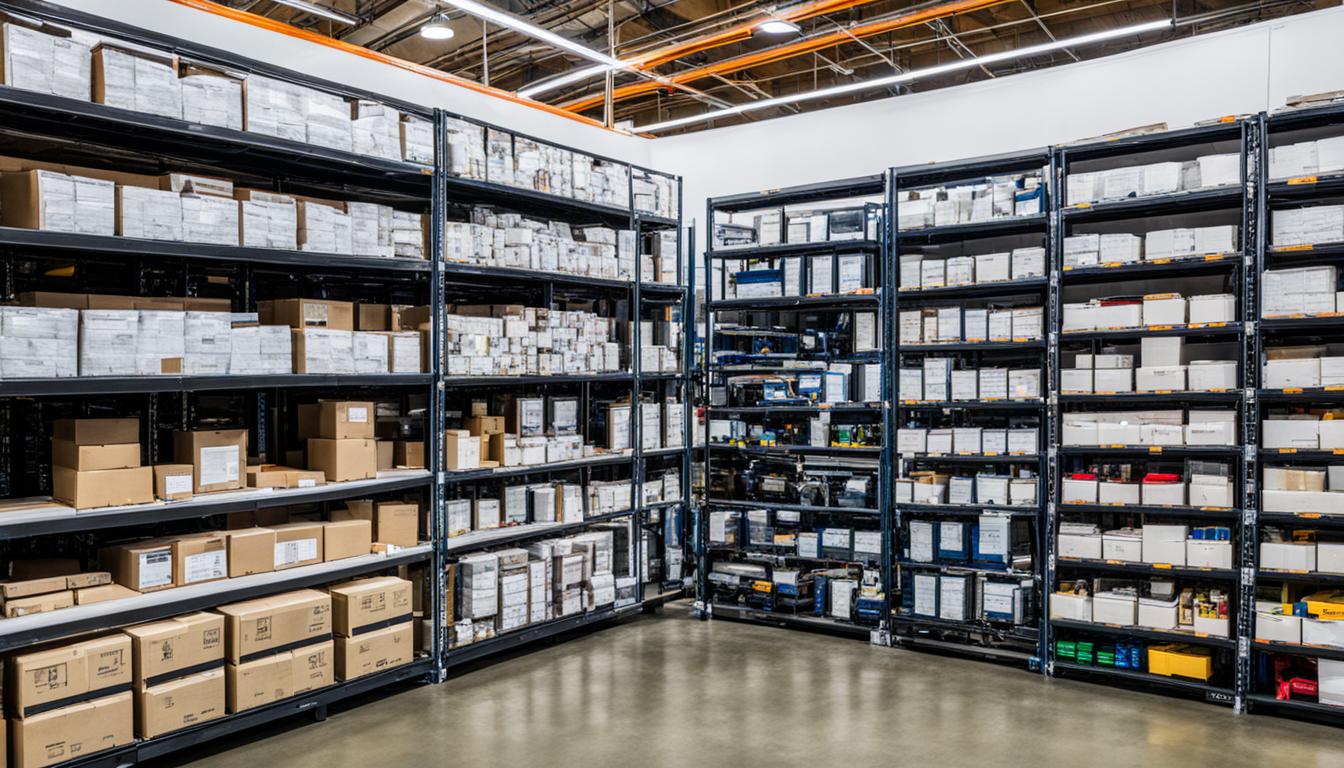Vendor-managed inventory (VMI) is a method where the supplier, often the manufacturer, takes over managing the distributor’s stock. In VMI, the vendor places inventory in the retailer’s warehouse. They use special software to check stock and fill up as needed. This system lessens the retailer’s workload, allowing the vendor to decide when and how much to order based on sales, delivery times, and production.
This method can cut down inventory costs and reduce stockouts. It also makes the relationship between the supplier and retailer stronger. This happens by sharing information and working together more closely.
Using VMI lets businesses see further in their supply chain. It helps predict how much stock is needed better. Plus, it makes it easier to measure how well vendors are doing. This helps manage contracts, lower risks, and plan well between sellers and buyers.
Vendors can handle their stock more efficiently with VMI. They can buy better, improving how they serve their customers’ stock needs.
Understanding Vendor Management Inventory (VMI)
Vendor-managed inventory (VMI) is a way for suppliers to control stock in a retailer’s shop. The supplier keeps track of what’s selling and restocks it as needed. This takes the ordering job off the retailer, making things smoother.
What is Vendor-Managed Inventory?
Vendor-managed inventory is when the supplier looks after the customer’s stock. They watch what’s being used and sold, then decide when to restock. This method helps keep the right amount of products on the shelves without too much or too little.
How a VMI System Works?
In VMI, the retailer and vendor connect through technology like EDI or online systems. The vendor analyses data to predict demand and keeps the right amount of stock available. This keeps the supply chain running well.
A good VMI system shares data in real-time, uses smart analytics, and is very automated. The goal is to have the right amount of stock to meet customer needs, cutting down on both overstock and stockouts.
| Metric | Description | Optimal Range |
|---|---|---|
| Perfect Order Fulfillment Rate | The percentage of orders that are fulfilled without any errors or delays. | 99.8% |
| Inventory Turnover Rate | The number of times inventory changes over a certain period. | Varies by industry |
| Stock to Sales Ratio | The relation of stock to sales which shows how well stock matches sales. | Varies by industry |
| Sell-Through Rate | The percentage of products sold in a set time. | Varies by industry |
VMI and traditional stock management differ in who controls the stock and restocks it. In VMI, the supplier does this, freeing the retailer to focus on their main work.
“VMI helps businesses cut costs everywhere in the supply chain. It does this by stopping unnecessary orders, reducing the amount of storage needed, and avoiding wrong amounts of inventory.”
Key Vendor Management Inventory Metrics
When setting up a vendor management inventory (VMI) deal, the seller and the buyer pick key metrics. These metrics are called key performance indicators (KPIs). They are important for both parties to make good choices about the inventory. Knowing these metrics well is vital for the VMI to work smoothly.
Inventory Turnover Rate
The inventory turnover rate shows how fast a company sells and replaces its stock. It is found by dividing the cost of goods sold by the average of inventory values. A higher rate usually means the company is managing its stock well.
Stock to Sales Ratio
The stock to sales ratio compares how much stock is available to how much is sold. It helps to see if the company has too much or too little stock. Balancing these can meet customer needs better.
Sell-Through Rate
The sell-through rate tells us how well a company turns its stock into sales. It shows if the supply chain and vendor’s management strategies are effective. A high sell-through rate is what businesses strive for.
| Metric | Description | Calculation |
|---|---|---|
| Backorder Rate | The number of delayed orders as a percentage of total orders | (# delayed orders due to backorders / total # orders placed) x 100 |
| Supplier Quality Index (SQI) | An overall ranking of a vendor’s quality, delivery, and issue resolution | Depends on what areas were agreed to be rated |
These measures show what’s happening with stock, sales, and how well a vendor works. They help with making a VMI plan and putting it into action.

“Inventory metrics are key for wise decisions in a vendor-managed system. By watching these KPIs, both retailers and suppliers can improve how they handle stock.”
Benefits of Vendor Management Inventory
Vendor-managed inventory (VMI) has lots of perks for retailers and suppliers. It lets retailers focus on their main work while getting big operational and financial wins. It takes the hassle out of managing stock, giving them time for what they do best.
Lean Inventory
VMI helps keep inventory lean. Vendors get live sales data and forecasts to manage stock better. This means retailers don’t need lots of extra stock. It cuts their costs and lets them spend money on other key areas.
Lower Operating Costs
VMI cuts retailers’ operating costs. They don’t need as many resources for stock management tasks. This means saving on warehouse and staff costs. It lets them put more money into making customers happier and growing their business.
Stronger Supplier Relationship
VMI builds stronger supplier relationships by sharing insights and working closely. With better understanding of what customers want, suppliers can meet retailers’ needs more effectively. This leads to better stock predictions, fewer out-of-stock times, and a smoother supply chain.
VMI also offers better data, faster stock turnover, and shorter lead times. By working with their vendors’ knowledge and tools, retailers can manage their stock optimally. This cuts costs and makes everything run more smoothly.

Drawbacks of Vendor-Managed Inventory
Vendor-Managed Inventory (VMI) has more pros than cons. Yet, there are a few challenges to think about. To make VMI work well, you need to plan carefully, agree clearly, and keep talking.
Communication Challenges
Changes in stock, like new products or ones being stopped, can confuse retailers and vendors. Good communication is vital. It helps everyone know the status of stock and any changes.
Data Quality Issues
Having wrong or not enough data on sales, stock, and forecasts might lead to too much or too little stock. For VMI to be useful, the data must be correct and reliable. This gives real insights.
Cultural Resistance
Some retailers and vendors might not want to give up how they manage stock. To tackle this, they need to change their views. They should see how VMI can help their partnership.
Unclear Responsibilities
If it’s not clear who’s in charge of problems like slow items or throwing stock away, it can cause issues. It’s key to clearly lay out who does what. This makes VMI work without problems.
| Drawback | Description |
|---|---|
| Communication Challenges | Lack of transparency around inventory changes, such as new product introductions or discontinuations, can create problems between retailers and vendors. |
| Data Quality Issues | Insufficient or inaccurate data on sales, inventory levels and demand forecasts can lead to stockouts or overstocking. |
| Cultural Resistance | Retailers and vendors may be hesitant to relinquish control over inventory management processes. |
| Unclear Responsibilities | Ambiguity around who is accountable for issues like slow-moving items or inventory write-offs can create friction between retailers and vendors. |
To make VMI work well and get all its benefits, these issues need handling. Good communication, accurate data, and clear responsibilities are key. They help organisations make the most of Vendor-Managed Inventory.

“Vendor-Managed Inventory requires a shift in mindset and a shared understanding of the benefits it can bring to the partnership.”
When to Use Vendor Management Inventory?
The Vendor Management Inventory (VMI) works best for shops with lots of different kinds of products. These shops buy from many suppliers. It’s hard for them to keep track of all the stock coming in. With VMI, the shop lets the suppliers look after the stock. This means they keep items in stock without the shop having to worry. Sales can keep going smoothly this way.
If a shop sells items that people want at certain times, they can benefit from VMI. Shops that need to restock a lot can also find VMI helpful. Vendors can handle the changes in stock well. This makes sure items are back on the shelves quickly. This is good for shops that use few materials and get them from one place. Yet, more shops are turning to VMI to run their supply chain better and do more.
Take fasteners, for example. They aim to have just enough stock, not too much. They do this by predicting what’s needed and planning as demand changes. Using VMI means the shop doesn’t worry about the supply chain. Too much stock can take up space and slow work down. Nearly 85% of supply chain costs are for people, not the parts.
Adding more suppliers can become very expensive for a shop. Without VMI, the costs can go over £1 million in five years. VMI keeps the shelves stocked better. It aims to use time and money well. This is unlike letting each supplier handle their stock. That can lead to more expensive, sudden buys instead of saving money with smart planning.
| Benefit | Description |
|---|---|
| Reduced inventory costs | Optimising stock levels to minimise carrying costs |
| Lower stockouts | Ensuring products are available to meet customer expectations |
| Stronger customer relationships | Optimised inventory management leading to better service |
| Streamlined operations | Freeing up time to focus on core business activities |
| Improved cash flow | More accurate demand forecasting |
| Detailed inventory data | Better decision-making through improved insights |
| Enhanced supplier relationships | Better collaboration and potential loyalty programs |
VMI brings many good things but also a few challenges. Shops might not control stock as much, for one thing. There’s also a risk in sharing private sales data with the suppliers. Plus, shops start to rely a lot on what the suppliers use to manage the stock. Yet VMI is getting more popular, especially in food stores. It’s good at making sure there’s always enough stock and improving how shops deal with customers.
Companies Using Vendor Management Inventory
Many top companies are now using vendor-managed inventory (VMI). VMI lets suppliers and buyers work closely. They aim to keep just the right amount of stock on hand and make the supply chain run smoother.
- Walmart: This retail giant is a VMI expert. It optimises its stock across thousands of stores with help from suppliers.
- The Home Depot: This home improvement store teams up with vendors for its DIY and pro customers’ needs, thanks to VMI.
- Amazon: The e-commerce giant uses VMI for its huge range of products, making sure they are almost always available.
- Procter & Gamble: They use VMI to keep their popular items in stock at retail stores, making the supply chain work better.
These companies have found VMI to be a win. It helps them keep stock levels skinny, cutting costs and making things smoother. Their supplier ties get stronger, making customers’ happy and the business grow.
| Company | Industry | VMI Benefits |
|---|---|---|
| Walmart | Retail | Optimised inventory levels, reduced costs |
| The Home Depot | Home Improvement | Improved inventory management for DIY and professional customers |
| Amazon | E-commerce | Streamlined e-commerce inventory management for vast product catalogue |
| Procter & Gamble | Consumer Goods | Ensured availability of fast-moving products for retail partners |
By using VMI, these leading firms are doing key things better. They’re improving their stock, saving money, and making the supply chain more efficient. This lets them focus on what they do best. They’re boosting customer satisfaction and growing their businesses.
Setting Up a Successful Vendor Management Inventory System
Starting a vendor management inventory (VMI) system means taking key steps. First, both sellers and suppliers need to check if VMI suits their needs. They should look at how much they sell, what is wanted, and what the suppliers can do. After deciding VMI fits, they should set up real goals.
Determine If VMI is the Right Fit
Finding out if VMI works is crucial. Sellers and suppliers must look at their sales, what buyers want, and what the suppliers can offer. This helps make sure VMI meets their specific needs and brings the promised perks.
Set Realistic Expectations
Talking about what VMI can achieve, with the supplier, is key. Getting clear, agreed goals and setting real expectations make VMI work better. This way, moving to VMI is smooth, and both sides know what to aim for.
Establish Seamless Information Transfers
Good info sharing is essential for VMI success. Sellers and suppliers should use solid data sharing methods, like EDI, to send real-time sales and stock info. This helps the supplier stock products better, making the whole supply chain work well.
It’s also smart to link the sellers’ and suppliers’ stock systems. This links them up, making data sharing automatic and reliable. So, both sides always have the same, up-to-date info, making working together easier.
Keeping in touch during VMI’s start is very important. Talking often about how things are going, fixing problems, and changing the plan as needed keeps the VMI partnership working well.
Follow these steps, and sellers and suppliers can create a top-notch VMI system. It will cut costs, make their business run better, and keep the supply chain humming.
Conclusion
Vendor-managed inventory (VMI) is a smart strategy in the supply chain. It helps retailers and suppliers both. Retailers can lower costs and handle stock better by letting vendors manage it. This also makes the relationship with suppliers stronger through better communication. Though it needs planning and clear talks, the benefits of VMI are usually more.
VMI is gaining more fans as it proves its worth. It’s a great help in managing stock, making things run smoother, and boosting the supply chain’s effectiveness. The secret to its success is sharing and using data well and building strong teamwork between suppliers and buyers. These things make VMI very popular in different fields.
For VMI to work, trust, shared goals, and a drive to always do better are necessary. When companies take up VMI, they can find new ways to stand out, make customers happier, and keep improving the supply chain. This is how VMI can really bring success.
FAQ
What are the key metrics used in Vendor Management Inventory?
Important measurements in VMI include how quickly products sell, how much is left after selling, rates of selling, and quality ratings from the supplier. These help keep an eye on stock, sales, and how the supplier is doing. They make planning and running VMI better.
What are the benefits of Vendor Management Inventory?
VMI helps reduce how much stock is kept, lowers costs, and makes supplier bonds stronger. It also makes guessing how much to stock better, lessens chances of running out, and makes getting products simpler.
What are the potential drawbacks of Vendor-Managed Inventory?
VMI’s downsides can be messy communication, bad data, cultural problems, and not knowing who does what. But, with good planning and clear talks, these can be avoided. This helps make VMI work great.
When is Vendor Management Inventory most suitable?
VMI fits well for shops with many products, that change a lot through the year, or need restocking often. This way, the shop can let the suppliers handle managing the stock. It helps boost sales all the time.
Which companies use Vendor Management Inventory?
Big names like Walmart, Home Depot, Amazon, and Procter & Gamble use VMI with their suppliers. They find that working closely with suppliers this way saves money and works better.
How can a successful Vendor Management Inventory system be set up?
Setting up VMI right means making sure it fits, keeping goals real, sending info smoothly, merging systems, and always talking. This keeps the shop and the supplier working well together.




